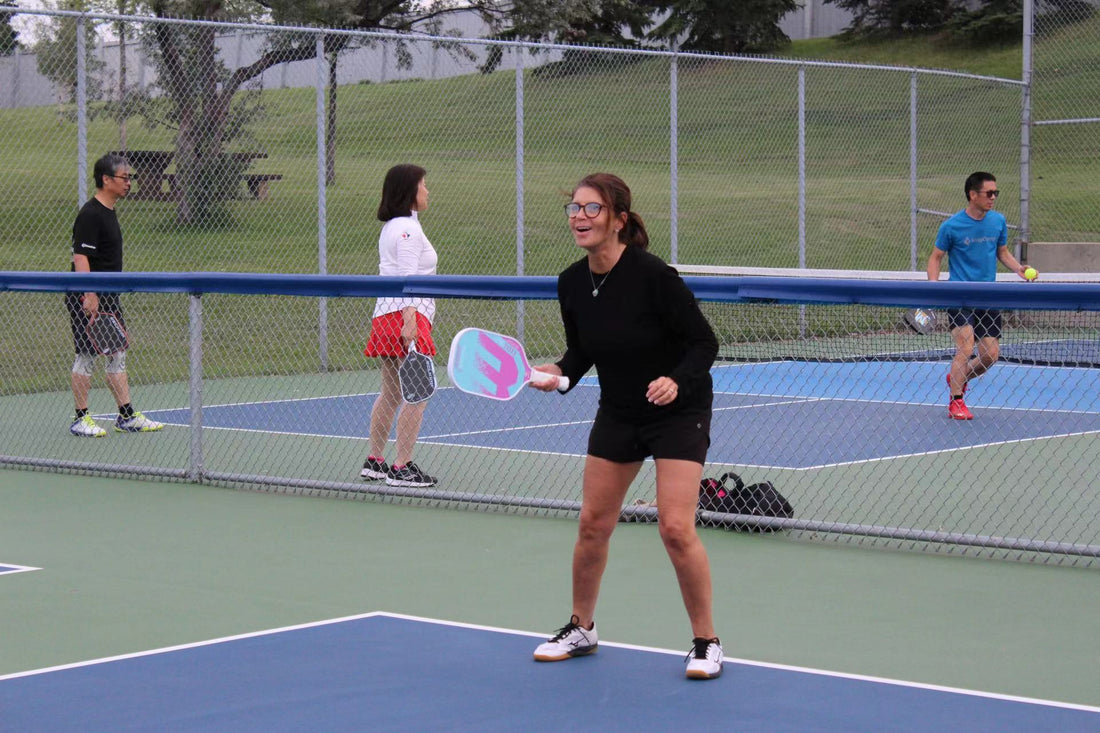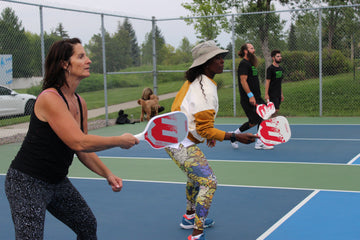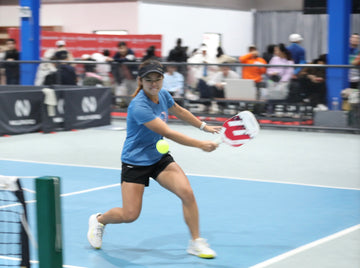The Difference Between Pickleball and Tennis

Pickleball and tennis are both popular racquet sports, but they have distinct differences that set them apart.
1. Court Size and Equipment
Pickleball:
- Played on a smaller court, measuring 20 feet wide and 44 feet long for doubles, and 20 feet wide and 22 feet long for singles.
- Players use a paddle, typically made of wood or composite materials, and a plastic ball with holes, similar to a whiffle ball but slightly smaller.
Tennis:
- Played on a larger court, measuring 27 feet wide and 78 feet long for singles, and 36 feet wide and 78 feet long for doubles.
- Players use a tennis racquet, usually made of graphite or other composite materials, and a felt-covered rubber ball.
The differences in court size and equipment contribute to the distinct playing styles and strategies of each sport. While pickleball is known for its quick, close-to-the-net action, tennis often involves longer rallies and more court coverage.
2. Scoring System
Pickleball:
- Games are played to 11 points, and you must win by 2 points.
- Only the serving team can score points.
- The serving team continues to serve until they commit a fault (such as hitting the ball out of bounds or into the net).
- Each side gets only one serve attempt, except in the case of a let (a serve that touches the net but still lands in the correct service court, which results in a replay of the point).

Tennis:
- Games are scored starting at "love" (zero) and progress to 15, 30, 40, and game point.
- If both players or teams reach 40 (known as "deuce"), one must win by two points to win the game.
- After deuce, the next point won by a player is called "advantage." If the player with advantage wins the next point, they win the game. If they lose the point, it goes back to deuce.
- A set is typically played to 6 games, but a player/team must win by a margin of 2 games. If the set reaches 6-6, a tiebreaker is usually played to determine the winner of the set. In a tiebreaker, the first player/team to reach 7 points with a margin of 2 wins the tiebreaker and the set.
- Matches are usually best of three sets, but in some cases, such as Grand Slam events for men, they are best of five sets.
3. Serving Technique
Pickleball:
- The serve must be hit underhand.
- The server must stand behind the baseline and hit the ball into the diagonally opposite service court.
- The serve must clear the non-volley zone (the area near the net commonly referred to as the "kitchen").
- The serve is typically hit with a slight upward trajectory to ensure it clears the net and lands in the correct service court.

Tennis:
- The serve is typically hit overhand.
- The server must stand behind the baseline and hit the ball into the diagonally opposite service box.
- The serve must land in the service box diagonally opposite the server and must clear the net.
- The serve in tennis is often hit with topspin or slice to control its trajectory and speed.
In both sports, the serve is an important part of the game and can set the tone for the point that follows. Players often vary their serve placement and speed to keep their opponents off balance.
4. Gameplay and Strategy
Pickleball:
- Pickleball is typically played as a doubles game, though singles play is also common.
- The court is smaller than a tennis court, which leads to faster-paced rallies.
- Due to the smaller court size, players need to be quick and agile, with good reflexes and the ability to cover the court efficiently.
- The non-volley zone (kitchen) near the net adds a strategic element, as players cannot hit volleys while standing in the kitchen, requiring them to move in and out of the zone strategically.
- The game often involves dinking (soft shots) and volleys, as well as occasional smashes (hard shots hit downward) to end points.
- Strategy often involves placement of shots to exploit opponents' weaknesses, as well as teamwork and communication in doubles play.
Tennis:
- Tennis can be played as singles (one player on each side) or doubles (two players on each side).
- The court is larger than a pickleball court, which allows for longer rallies and more opportunity to hit powerful shots.
- Players need good endurance, as tennis matches can be physically demanding, especially in longer matches or in hot weather.
- Different surfaces (such as grass, clay, and hard courts) can affect gameplay and strategy.
- Strategy in tennis often involves using a combination of shots (such as groundstrokes, volleys, and serves) to control the point and set up opportunities to hit winners (shots that the opponent cannot return).
- Players often use tactics such as hitting to their opponent's weaker side, varying the pace and spin of their shots, and approaching the net to hit volleys.
5. Physical Demands
Both pickleball and tennis require physical fitness and agility, but the specific demands can vary due to differences in court size, game duration, and playing style:
Pickleball:
- Pickleball is played on a smaller court than tennis, which can lead to quicker movements and shorter, more explosive bursts of energy.
- The game requires good lateral movement, as players need to cover the court from side to side quickly.
- Pickleball can be less physically demanding in terms of endurance compared to tennis, as points tend to be shorter and the game is played to 11 points per game, rather than games to 15, 30, or 40 as in tennis.
- However, pickleball can still be physically demanding, especially in longer matches or in doubles play where players need to cover more ground.
Tennis:
- Tennis is played on a larger court, which requires more running and endurance compared to pickleball.
- Matches can be longer, especially in higher-level play or in five-set matches, which can require greater physical stamina.
- Tennis players need to be able to perform a variety of movements, including sprinting, stopping quickly, changing direction, and lunging to reach shots.
- The physical demands of tennis can vary depending on playing style, with aggressive baseliners and serve-and-volley players often requiring different physical attributes.
Subscribe Us
Subscribe to our newsletter and receive a selection of cool articles every weeks









